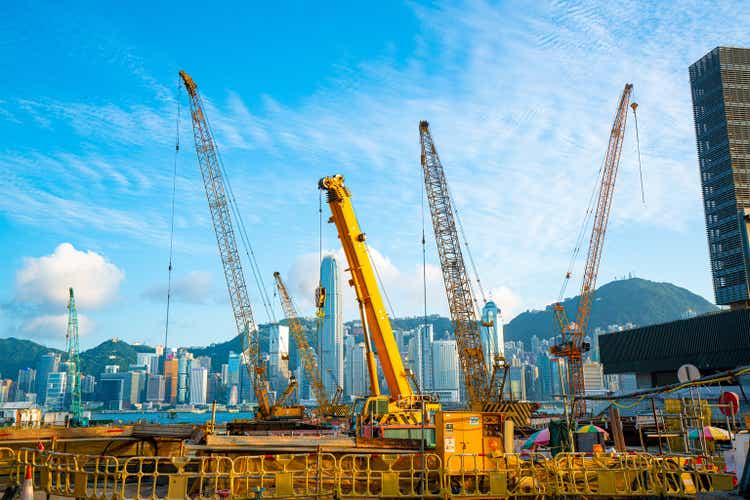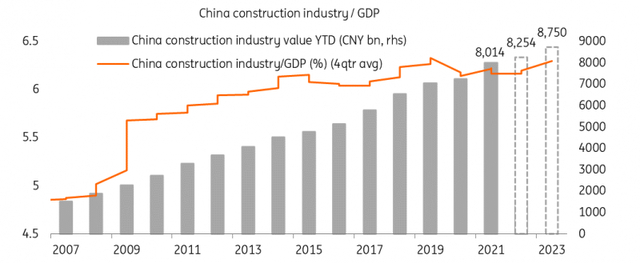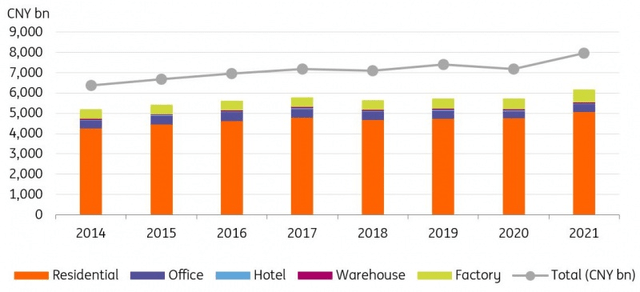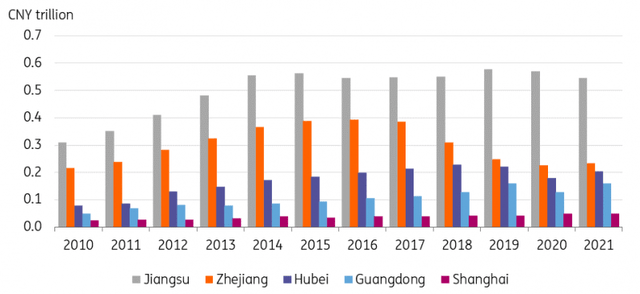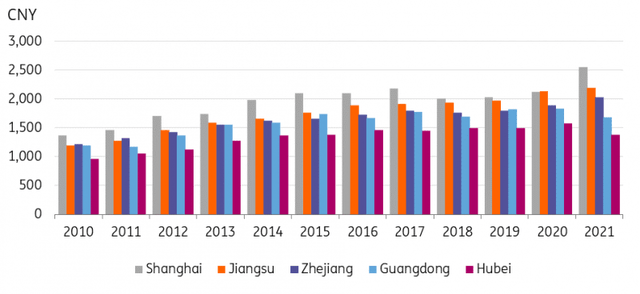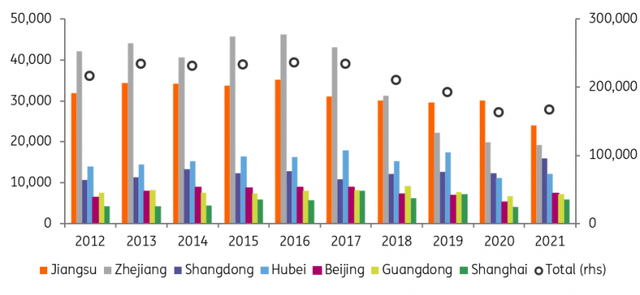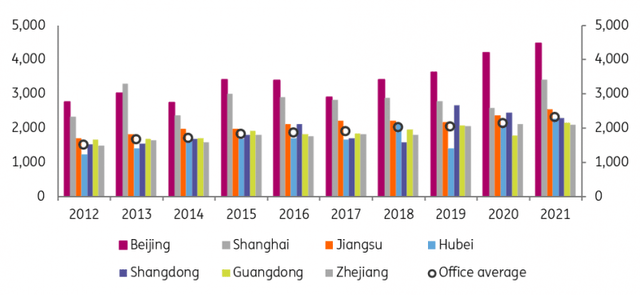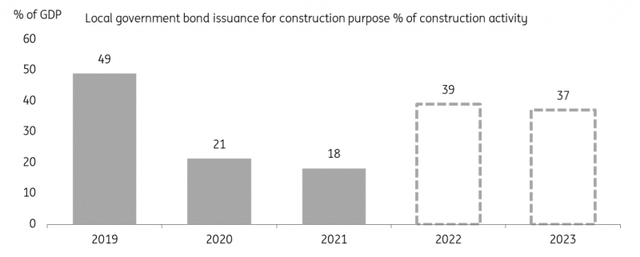[ad_1]
CHUNYIP WONG/E+ via Getty Images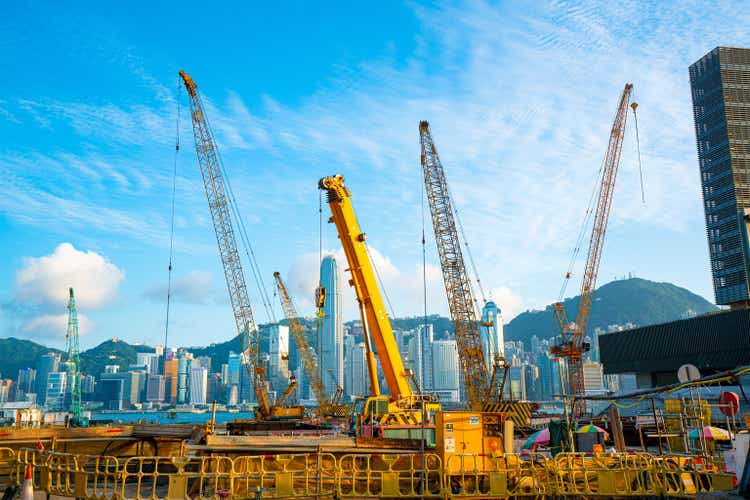
By Iris Pang, Chief Economist, Greater China
Overview of China’s construction sector
China’s construction industry averaged 6.2% of GDP (equivalent) over the four quarters ending in the first quarter of this year. The value-added from this sector was CNY8 trillion in 2021. Construction grew only 2% in 2021, down from 4% in 2020, as residential real estate developers came under deleveraging reforms.
This article is going to separate construction activity into real estate and infrastructure investment.
We expect only mild growth of construction activity in 2022 – about 3% – mainly from infrastructure and affordable housing investment. This is lower than our projected nominal GDP growth rate of 6.3% for 2022 (the real GDP growth forecast is 4.4%) due to the effects of ongoing deleveraging reforms on property developers.
China’s construction activity as a share of GDP
2023 should be better than 2022
We forecast that residential construction activity will contract in 2022 as some property developers will be unable to fund new construction due to tight liquidity and will find it difficult to refinance in the bond and loan markets. Incomplete residential projects should still be finished with the help of local government and bank funding, which should be considered “emergency funding”, and not a long-term solution to the residential property market. As such, past-due mortgages on those uncompleted homes should enjoy payment holidays until completion.
The current incidence of mortgage payment boycotts from some borrowers unhappy about their exposure to challenged developers will further expose cash-tight developers’ weaknesses and make it even more difficult for them to raise funds for future growth. M&A activity is likely in this segment. Office construction may experience only mild growth due to the uncertainty caused by Covid lockdowns and reforms in the technology sector.
Other construction activities in 2022 should mostly come from infrastructure projects. As of April, 38 projects were approved with a total investment amount of CNY533 billion. From January to April, the new starts of infrastructure projects increased by 28% year on year. Although this growth rate seems high, the amount of investment is less than that targeted. This is due to lockdowns that have slowed down administration processes and made it difficult to get workers to construction sites. But these difficulties should ease in the second half of the year as we assume there will be fewer and more targeted lockdowns.
Looking ahead to 2023, construction industry value-added should rise to CNY8.75 trillion, following a growth rate of 6%. That is still slower than our estimate of nominal GDP growth of 7.9% for the year (the real GDP growth estimate is 5.6% for 2023). There should be a pickup of commercial property construction, and further construction of infrastructure projects spilling over from 2022, but almost no growth in residential property construction in 2023. All this assumes that there will be fewer and shorter lockdowns in 2023 compared to 2022.
China residential property market overview
China residential property market overview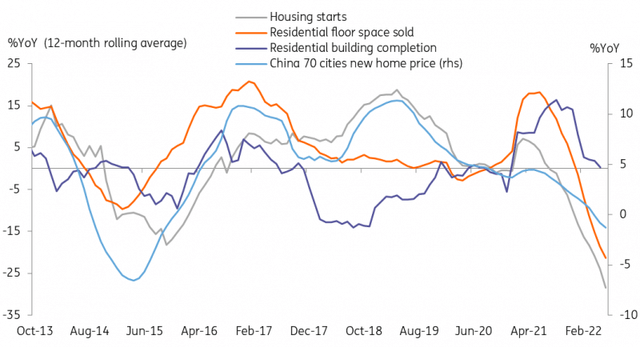
Policy is the key driver of the downward trend of real estate activity
There are two major policies that have accelerated deleveraging reform, namely the “three red lines” and land auction rules.
1. The three red lines
Deleveraging reform of the real estate sector has been on the agenda of each year’s government policy framework for some time. The government has reiterated that residential housing is for residential purposes, not for speculation. These reforms gathered pace in 2020. In August 2020, the government imposed the “three red lines” policy on all real estate companies, with the aim of reducing their leverage ratios.
The “three red lines” are the following indicators:
- Gearing ratio of no more than 70% after excluding prepayments.
- Net debt ratio of no more than 100%.
- Cash to short-term debt ratio greater than 1.
All real estate companies are categorised into four different groups, depending on their financial health gauged by the three red lines. This limits the increase in their interest-bearing debt every year. The worst case cannot increase any interest-bearing debt each year, while the best case can increase the interest-bearing debt by 15%YoY at most.
In December 2020, regulators also announced that bank loans for the real estate sector would be monitored on a holistic basis. This pushed real estate companies that had not passed the three red lines to reduce their leverage ratios.
Following this, the government encouraged financially healthy real estate developers to undertake M&A, and banks informed cash-rich real estate developers in January 2022 that financing for acquisition would not be counted in the “three red lines”.
Results:
The three red lines policy will reduce leverage ratios for cash-tight property developers. The risk is that for those very cash-tight developers, even if they do not bid for land anymore, they are too cash-strapped to finish incomplete projects.
The government might need additional policies to speed up M&A activity in this sector so that uncompleted projects can be finished following acquisitions Otherwise, the burden of completion will fall onto local governments and the regional banks, which will increase the financial burden of local governments and increase bad debt ratios of banks.
2. Land auction rules
Land auction rules have also been refined. The government adjusted and refined land auction policies between February and September 2021. The main change was that each land auction bundled several land parcels in each auction lot. This means that only cash-rich property developers could participate in the auction. Further refinements of the policy include limiting the land premium ceiling to 15% and not raising home prices by raising the reserve price. The result not only limits the premium over land costs but also limits the supply of homes as fewer developers can bid for land.
Results:
This may be good in the short term, as it limits cash-tight property developers from further increasing their leverage ratios, and should help them to more quickly achieve the three red lines. However, the dip in land supply will lead to a similar decrease in home supply in the private market. If affordable housing supplies from the government cannot fill the gap, home prices will increase eventually.
Development of construction in 2022
We now turn to more data analysis on the construction industry to see the actual impacts of the deleveraging reforms.
China’s construction sector contains three big categories. These are residential property, non-residential property, and infrastructure. Fixed asset investment in construction has fallen from its peak in 2021 after the government announced the three red line policy and refined land auction rules for real estate. Currently, construction investment is contracting. We expect the industry to bottom between 2023 and 2024. But overall policy on real estate developers will probably not change as the purpose of the policies is still to reduce the overall leverage ratio of the real estate sector.
In contrast to real estate construction, infrastructure investment will rise after funding from local government special bonds are allocated to specific infrastructure projects in the second half of 2022. We will explain more later in this article.
Fixed asset investment of construction (%YoY YTD)
Completion value of real estate construction
China’s building construction completion value* totalled CNY7.94 trillion in 2021. Among all building construction, residential construction made up 63% of the total. The rest was mostly office buildings and factories. The residential completion share came down from 66% of the total in 2020. This was because some bonds of residential property developers defaulted in 2021.
We expect that the completion value of residential buildings will fall to between 50-60% in 2022, but should pick up in 2023 as local governments step in to finish some uncompleted projects. But even with the intervention of local governments, building activity should be slower for the industry as a whole as cash-tight developers will still find it difficult to access bond markets for funding.
*Construction completion values are the values of the floor space of buildings that are completed in the reference period in accordance with the requirements of the design, up to the standard to be put into use.
Building completion value
Top cities for residential construction – not Shanghai, Beijing, or Shenzhen
It may come as a surprise to learn that Shanghai, Shenzhen, and Beijing were not among the top cities in China by building construction completion values. Instead, Jiangsu and Zhejiang have been the top two cities for more than a decade.
Top five cities by residential property completion
What type of building activity have Jiangsu and Zhejiang completed to achieve such prominence in construction?
Jiangsu and Zhejiang ranked in the top two in terms of residential area completed, though Shanghai has been at the top of the most expensive cities in terms of value per square meter (SQM) in the residential market for nine out of the last 10 years. But still, it is surprising to see that Jiangsu and Zhejiang ranked in the top three for value per sqm in the residential construction market. The two locations comprise electronic and computing industries, which makes their GDP growth rates high compared to some other cities. Moreover, Jiangsu has the highest GDP per capita of Chinese provinces and is also the most densely populated city in China. Zhejiang province’s capital city is Hangzhou, which is a hub of technology companies.
Top five cities for residential completion value per sqm
Office space paints a different picture in terms of price per sqm
Demand for office space is also strong in Zhejiang and Jiangsu. But these demands are not enough to push office values to levels comparable to Beijing and Shanghai.
There are two possible explanations for that. The first is that under Covid’s tight social distancing measures, and with Zhejiang and Jiangsu more technology-based locations, working from home has become more viable. Second, reforms in the technology sector also affect occupancy rates of offices as some smaller companies might not have survived the reforms, and some larger technology companies have been shrinking some of their business lines.
Office space completed in China’s top five cities (sqm ‘000)
Top five cities for office completion value per sqm
There is not enough affordable housing to replace the private home supply
The government is trying to turn many shanty towns into affordable housing. The first issue is moving existing residents to a new place. This year, the government found a new way to do this – it hands out vouchers to residents in shanty towns which act as subsidies to buy new homes. This should give home sales a boost.
Then, cash-rich developers can demolish the shanty towns and start building affordable housing. We do not expect any property developers that have defaulted on their bonds or that are involved in uncompleted projects to be able to enter the bidding process to build these projects.
The future funding source for real estate developers
Funding for real-estate property construction, including residential property construction, will still depend heavily on China’s bond markets. But only cash-rich property developers will be able to access the bond market without incurring a high-risk premium. Defaulted property developers may not be able to return to the bond market to raise funds until their financial ratios improve.
Infrastructure construction
In 2022, local government special bonds will be an important funding source for infrastructure construction activity. The share of local government funding for infrastructure construction activity should rise to 39% in 2022 from 18% in 2021.
Local government bond issuance for construction activity
According to the Ministry of Finance, as of 15 May 2022, the new issuance of local government special bonds amounted to CNY1.5 trillion, an increase on the CNY1.3 trillion from the same period last year. The target of local government special bond issuance this year is CNY3.65 trillion, of which around 95% has been allocated to infrastructure investments.
We expect the issuance target for local government bonds at CNY3.65 trillion will stay the same in 2023, some infrastructure projects should be funded by Public-Private-Partnerships. Although there is funding support from local governments, we expect that the government will closely monitor the financial health of construction companies for infrastructure projects to avoid more risks arising from the construction sector.
Predictions for the residential property market
We do not think that the central government will change its stance on deleveraging reforms for real estate developers. As a result, the three red lines and the tightened land auction rules will remain in place. The reforms have resulted in a number of uncompleted projects and this has led to delayed repayments of mortgages by some home buyers (a mortgage boycott). Local governments have stepped in to finish these uncompleted projects. Construction activity has been supported, but will still probably be slower in 2022 than 2021 with a potential recovery in 2023-24 depending on whether there is more M&A activity in the industry, which should help leverage ratios to fall.
But with the three red lines and the tightened land auction rules in place, the supply of land and therefore homes is likely to fall in the coming years. This may be an issue as reduced supply could eventually push up home prices, even as the central government increases the affordable housing supply in the near term. We, therefore, expect home prices to rise in the medium term (2023-27) but fall 5% in 2022 and probably into the first half of 2023 for Shanghai, Beijing, and Shenzhen. Locations that suffer from uncompleted projects will see a bigger fall in home prices.
Infrastructure construction activity is going to fill the gap left by the residential property market. The risk is that some local governments commence their construction activities too late to support growth in 2022.
Content Disclaimer
This publication has been prepared by ING solely for information purposes irrespective of a particular user’s means, financial situation or investment objectives. The information does not constitute investment recommendation, and nor is it investment, legal, or tax advice or an offer or solicitation to purchase or sell any financial instrument. Read more.
Editor’s Note: The summary bullets for this article were chosen by Seeking Alpha editors.
[ad_2]
Source link
